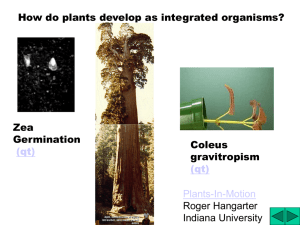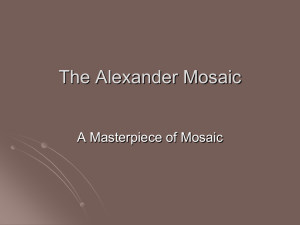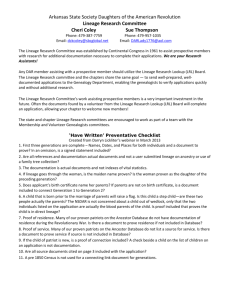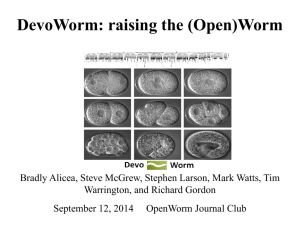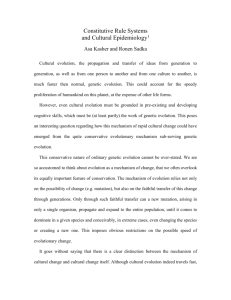The Network Architecture of Embryo Developmental Regulation
advertisement
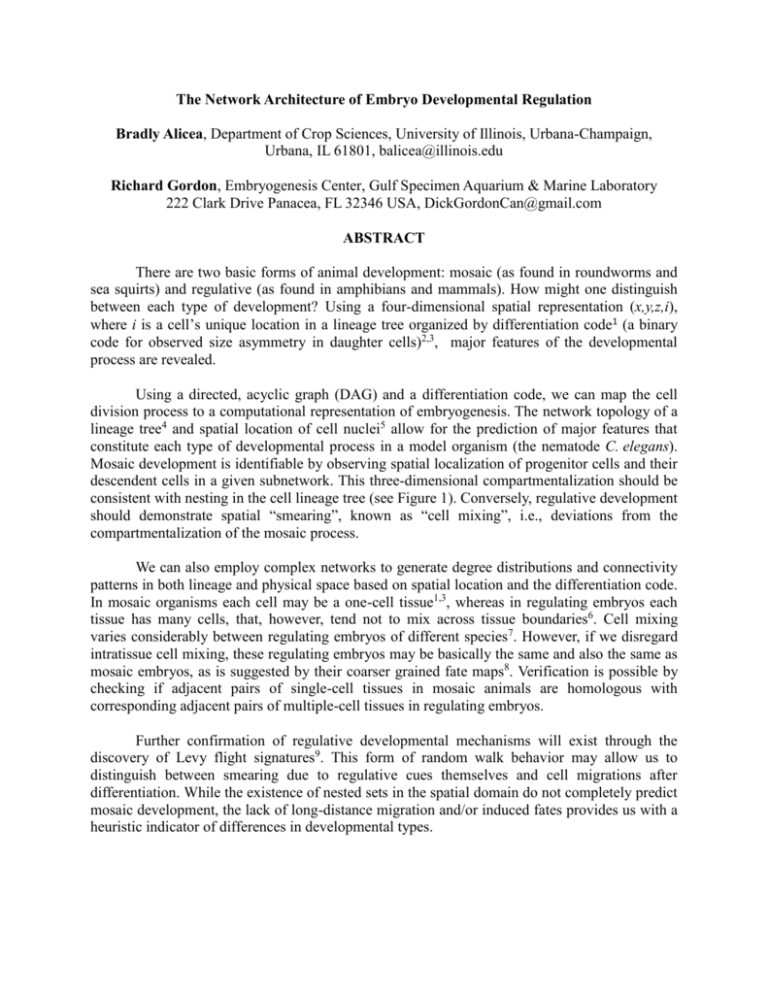
The Network Architecture of Embryo Developmental Regulation Bradly Alicea, Department of Crop Sciences, University of Illinois, Urbana-Champaign, Urbana, IL 61801, balicea@illinois.edu Richard Gordon, Embryogenesis Center, Gulf Specimen Aquarium & Marine Laboratory 222 Clark Drive Panacea, FL 32346 USA, DickGordonCan@gmail.com ABSTRACT There are two basic forms of animal development: mosaic (as found in roundworms and sea squirts) and regulative (as found in amphibians and mammals). How might one distinguish between each type of development? Using a four-dimensional spatial representation (x,y,z,i), where i is a cell’s unique location in a lineage tree organized by differentiation code1 (a binary code for observed size asymmetry in daughter cells)2,3, major features of the developmental process are revealed. Using a directed, acyclic graph (DAG) and a differentiation code, we can map the cell division process to a computational representation of embryogenesis. The network topology of a lineage tree4 and spatial location of cell nuclei5 allow for the prediction of major features that constitute each type of developmental process in a model organism (the nematode C. elegans). Mosaic development is identifiable by observing spatial localization of progenitor cells and their descendent cells in a given subnetwork. This three-dimensional compartmentalization should be consistent with nesting in the cell lineage tree (see Figure 1). Conversely, regulative development should demonstrate spatial “smearing”, known as “cell mixing”, i.e., deviations from the compartmentalization of the mosaic process. We can also employ complex networks to generate degree distributions and connectivity patterns in both lineage and physical space based on spatial location and the differentiation code. In mosaic organisms each cell may be a one-cell tissue1,3, whereas in regulating embryos each tissue has many cells, that, however, tend not to mix across tissue boundaries6. Cell mixing varies considerably between regulating embryos of different species7. However, if we disregard intratissue cell mixing, these regulating embryos may be basically the same and also the same as mosaic embryos, as is suggested by their coarser grained fate maps8. Verification is possible by checking if adjacent pairs of single-cell tissues in mosaic animals are homologous with corresponding adjacent pairs of multiple-cell tissues in regulating embryos. Further confirmation of regulative developmental mechanisms will exist through the discovery of Levy flight signatures9. This form of random walk behavior may allow us to distinguish between smearing due to regulative cues themselves and cell migrations after differentiation. While the existence of nested sets in the spatial domain do not completely predict mosaic development, the lack of long-distance migration and/or induced fates provides us with a heuristic indicator of differences in developmental types. Figure 1. Example of spatial segregation by differentiation code (extracted from a 6-level lineage tree) in embryo space. References: 1. Gordon, R. (1999). The Hierarchical Genome and Differentiation Waves: Novel Unification of Development, Genetics and Evolution. Singapore & London, World Scientific & Imperial College Press. 2. Alicea, B., S. McGrew, R. Gordon, S. Larson, T. Warrington & M. Watts. (2014). DevoWorm: differentiation waves and computation in C. elegans embryogenesis. http://www.biorxiv.org/content/early/2014/10/03/009993 3. Gordon, N.K. & R. Gordon (2015). Embryogenesis Explained [in preparation]. Singapore, World Scientific Publishing Company. 4. Sulston, J.E., E. Schierenberg, J.G. White & J.N. Thomson (1983). The embryonic cell lineage of the nematode Caenorhabditis elegans. Dev. Biol. 100(1), 64-119. 5. Bao, Z.R., J.I. Murray, T. Boyle, S.L. Ooi, M.J. Sandel & R.H. Waterston (2006). Automated cell lineage tracing in Caenorhabditis elegans. Proceedings of the National Academy of Sciences of the United States of America 103(8), 2707-2712. 6. Fagotto, F. (2014). The cellular basis of tissue separation. Development 141(17), 33033318. 7. Wetts, R. & S.E. Fraser (1989). Slow intermixing of cells during Xenopus embryogenesis contributes to the consistency of the blastomere fate map. Development 105(1), 9-15. 8. Nishida, H. & T. Stach (2014). Cell lineages and fate maps in tunicates: Conservation and modification. Zoological Science 31(10), 645-652. 9. Fedotov, S., A. Tan & A. Zubarev (2015). Persistent random walk of cells involving anomalous effects and random death. Physical Review E 91(4), 042124.

